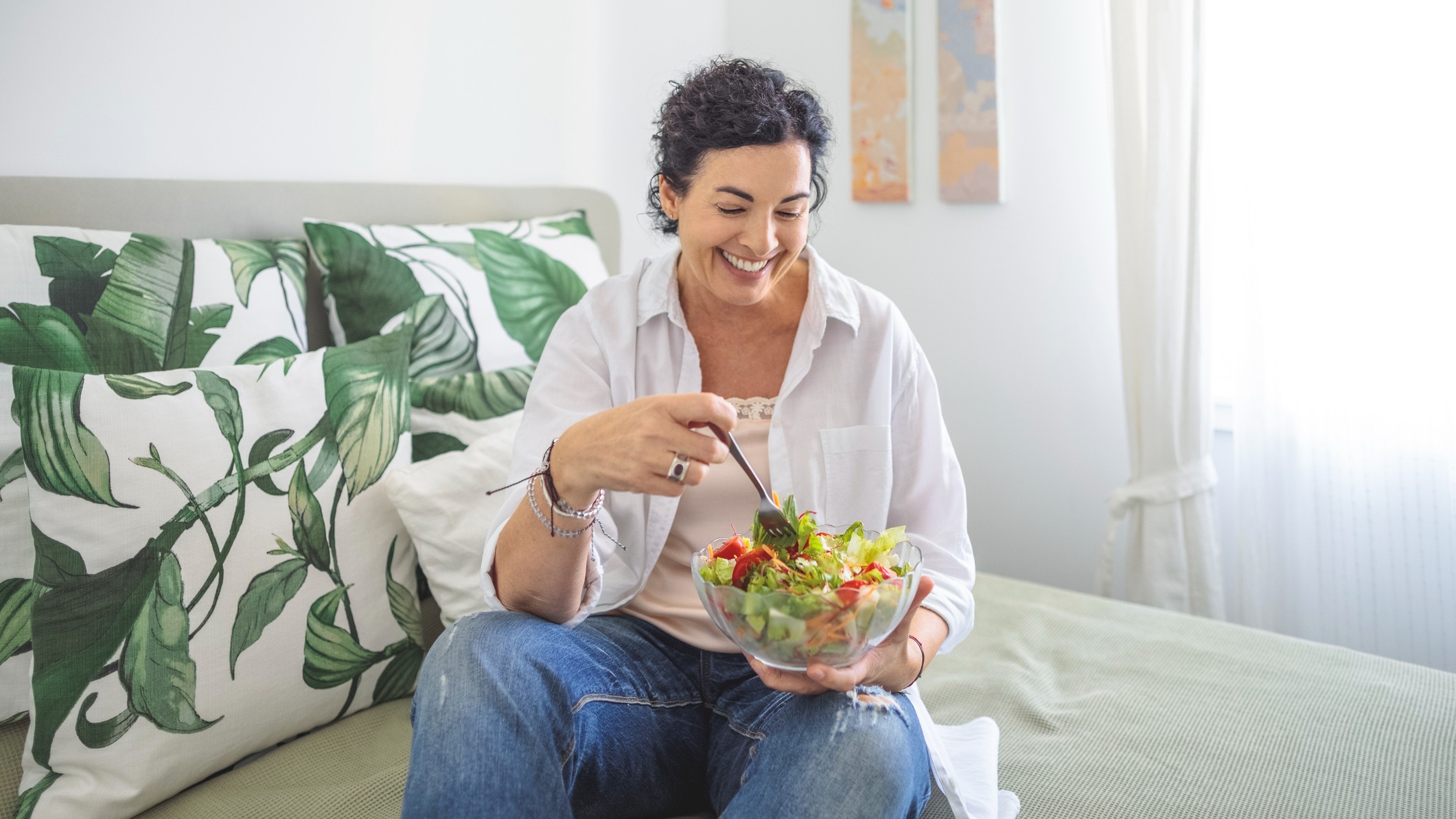Menopause diet plan to boost your energy and stabilize your mood
Sail through this tricky hormonal period with our menopause diet plan


With symptoms such as hair loss, anxiety and brain fog, the menopause can often feel like a hormonal rollercoaster. This is where our menopause diet plan comes in, designed to help you nourish yourself and optimize your wellbeing during this transition.
“Much like puberty, which is a huge transitional period in terms of hormones, the menopause also takes a toll on our body,” says registered nutritional therapist Jackie Lynch, author of The Happy Menopause. “This isn’t the time to be following a low-fat diet, because even though weight gain during the menopause can be an issue, the body uses fat to create sex hormones which often deplete during the menopause.”
To keep your blood sugar levels stable, your energy up and your hormones balanced, our menopause diet plan will help you to tweak the different components of your breakfast, lunch, and dinner and understand how to structure your plate. If you’re looking for extra support on top of your diet, read our guide to the best menopause supplements.
What to eat during menopause
The optimal menopause diet plan consists of balancing the main food groups, including protein, fat, and carbohydrates. “The good news is that food that contains protein will probably contain fat as well,” says Lynch. “Menopausal women need adequate protein in their diet for a range of reasons, such as balancing our blood sugar - which needs to stay stable to avoid those sugar cravings that lead to weight gain. A dip in our blood sugar can also release the stress hormone cortisol into the body and this interferes with our production of sex hormones as our body will prioritize cortisol over estrogen.”
A 2020 study found that during the menopause, women lose around 40% muscle mass and 25% of bone density. This is why good quality sources of protein are integral for menopausal women.
“Most people know we need to eat protein for muscle mass and bone density, both of which become an issue around the menopause,” says Lynch. “We also need the amino acids from protein, as these influence our memory, mood, and our concentration. Eating protein with every meal and every snack means your body isn’t producing more stress hormones which disrupt your brain functioning.”
Another important food group to factor into your diet is carbohydrates. “It’s important to eat wholegrain carbohydrates and starchy foods over sugary foods and white carbs during the menopause,” explains Lynch. “As the body uses carbs as its main form of energy, if we’re not exercising or moving enough, then any excess will be stored as fat.” Our guide on how to lose weight in menopause has more tips for avoiding menopausal weight gain.
Start your week with achievable workout ideas, health tips and wellbeing advice in your inbox.
The best menopause diet plan will include carbs in manageable portions. “Brown bread, wholegrain rice, and pasta are good because your body burns through these types of carbohydrates slowly, meaning your blood sugar is less likely to spike and you’re more likely to have healthy digestion,” says Lynch. “This is important because constipation puts pressure on the pelvic floor muscle which can cause urinary incontinence, a condition that many menopausal and post-menopausal women struggle with.”
Following pelvic floor exercises for women can also help to strengthen the pelvic floor during menopause.
Menopause diet plan: breakfast ideas
Once you hit your 40s and 50s, it’s time to tweak your diet. This means factoring in more protein, thinking about balancing your blood sugar levels, and considering your levels of micronutrients, such as magnesium, vitamin D, and omega-3 fatty acids. Here, Lynch has a meal plan to help you get started.
“The trick with breakfast is making sure you get that protein in,” explains Lynch. “If you’re a toast person, then stick to wholemeal toast to stop those blood sugar spikes. Avoid marmite and honey, which don’t add much nutritional value, and stick to toppings such as unsweetened nut butter, egg, or cottage cheese.

“If you’re a cereal person, then look at having a couple of tablespoons of chopped nuts and seeds instead of shop-bought muesli. My favorite ingredient to add to smoothies and muesli is flaxseed, as this has protein and fiber and it’s a great source of omega-3. Flaxseed also contains phytoestrogens, which are plant compounds that mimic the action of estrogen in the body. You should aim to add a couple of tbsps - around 20g – into your morning cereal or smoothie.”
Example breakfasts could be:
- Poached eggs on a slice of wholegrain bread.
- 2 tbsp of homemade muesli (with sunflower seeds, hazelnuts, and brazil nuts) with 150g of full-fat yogurt.
- Blueberry and spinach smoothie with 1-2 tbsp (20g) of flaxseed.
- Cottage cheese with a handful of fruit and a sprinkling of chopped nuts and/or seeds.
Once you hit your 40s and 50s, it’s time to tweak your diet. This means factoring in more protein, thinking about balancing your blood sugar levels, and considering your levels of micronutrients, such as magnesium, vitamin D, and omega-3 fatty acids. Here, Lynch has a meal plan to help you get started.
“The trick with breakfast is making sure you get that protein in,” explains Lynch. “If you’re a toast person, then stick to wholemeal toast to stop those blood sugar spikes. Avoid marmite and honey, which don’t add much nutritional value, and stick to toppings such as unsweetened nut butter, egg, or cottage cheese.
“If you’re a cereal person, then look at having a couple of tablespoons of chopped nuts and seeds instead of shop-bought muesli. My favorite ingredient to add to smoothies and muesli is flaxseed, as this has protein and fiber and it’s a great source of omega-3. Flaxseed also contains phytoestrogens, which are plant compounds that mimic the action of estrogen in the body. You should aim to add a couple of tbsps - around 20g – into your morning cereal or smoothie.”
Example breakfasts could be:
Menopause diet plan: lunch ideas
We often decide on our lunchtime meal in a bit of a rush, in between answering emails or taking a break from our screens. However, getting the right formula for lunch can not only help us to avoid the dreaded 4pm energy slump, but it can also help us to power through until dinner.

“Women will often have lots of green vegetables in salads, but forget about protein,” says Lynch. “If you are having a salad at lunch, aim for a fist-size portion of protein, such as a chicken breast, salmon steak, or quinoa. This will keep you full and your blood sugars stable into the afternoon. If you’re having soup, then make sure it’s chicken and vegetable or lentil. Soups such as tomato or carrot and coriander won’t supply you with enough protein.”
Example lunches could be:
- Green salad (spinach, cucumber and tomatoes) with chicken breast, feta cheese, and a sprinkling of pecans.
- Two slices of wholemeal bread with chunks of chicken, a tbsp of hummus, a handful of spinach, and chopped cucumber and tomato.
- Chicken and lentil soup with a wholemeal roll.
- Tuna mayo with a wholemeal pitta bread and chopped green salad (spinach, cucumber and tomatoes).
Menopause diet plan: dinner ideas
“For the evening meal, think about dividing the plate into four,” says Lynch. A quarter of our evening meal should be protein (think chicken, fish or tofu), and aim for a fist-size portion of this.
“Then your portion of starchy carb - such as rice, pasta or bread - should be no bigger than the protein. The next quarter should consist of leafy green vegetables, such as spinach, rocket, kale, broccoli, or watercress, and then the final part of your plates should contain any extra micronutrients – tomatoes, cauliflower, mushrooms, etc.”

Including leafy greens provides our bodies with magnesium, which is important for menopausal women as it boosts bone strength by assisting the absorption of calcium, and helps to regulate achy muscles.
Some example dinners could be:
- Salmon steak, new potatoes, spinach, and green beans.
- Chicken breast with avocado, rocket, tomato, watercress, and quinoa salad.
- Tofu curry with brown rice and broccoli.
- Lentil bolognese with wholegrain pasta and a portion of steamed spinach.
Stacey Carter is a Freelance Health Writer who has written print features and digital content for titles such as Woman & Home, Natural Health, Women’s Health, Get The Gloss, and Stylist. You'll find her covering a wide variety of health-based topics, talking to leading figures in the fitness industry, and investigating the latest trends in wellness. When she’s not at her laptop, weekend hikes, testing out new recipes in the kitchen and LISS-style workouts are her favourite ways to switch off.
